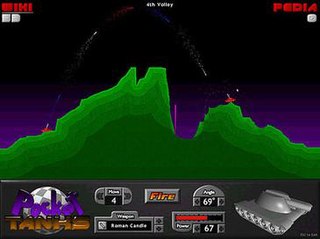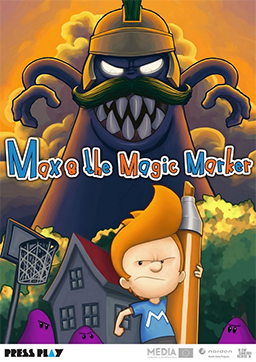
Uplink is a simulation video game released in 2001 by the British company Introversion Software. The player takes charge of a freelance computer hacker in a fictional futuristic 2010, and must break into foreign computers, complete contracts and purchase new hardware to hack into increasingly harder computer systems.

Pocket Tanks, often abbreviated as PTanks or simply as PT, is a 1- and 2-player computer game and mobile game developed by Michael P. Welch from Blitwise Productions. It was originally released for Windows and Mac OS X in 2001 and was later released for iOS in 2009 and Android in 2012. It is available as shareware as well as a premium version known as Pocket Tanks Deluxe, which includes the content from all 30 expansion packs.

Epic Pinball is a 1993 pinball video game developed by James Schmalz and published by Epic MegaGames. The initial release pre-dated Schmalz' Digital Extremes name. The game is played seen from a 2D top-down view within a scrollable window with plain raster graphics in 320x240. It was noted for being programmed entirely in x86 assembly language for MS-DOS systems.

Petri Purho is a Finnish game developer and a cofounder of the game studio Nolla Games. He has previously also worked at Finnish independent video game developer studio Frozenbyte. He is best-known for the roguelite Noita and the puzzler Crayon Physics Deluxe, which won the Seumas McNally Grand Prize at the Independent Games Festival in 2008.

Box2D is a free open source 2-dimensional physics simulator engine written in C++ by Erin Catto and published under the MIT license. It has been used in Crayon Physics Deluxe, Limbo, Rolando, Incredibots, Angry Birds, Tiny Wings, Shovel Knight, Transformice, Happy Wheels, and many online Flash games, as well as iPhone, iPad and Android games using the Cocos2d or Moscrif game engine and Corona framework.

I Love Katamari was a third-person puzzle-action video game developed by Namco Bandai Games for iOS. It is a continuation of the Katamari Damacy series of games. It was released worldwide in the App Store on December 14, 2008. A Windows Phone 7 version of the game was released in 2010. The version for Android was released in 2012 exclusively for Samsung Android devices. In this game, the King of All Cosmos instructs the game's protagonist – the Prince – to gather as many objects as possible to grow a highly adhesive ball called a Katamari large enough so that he can pick up special objects to bring to the King so that he can regain his memory.

Machinarium is a puzzle point-and-click adventure game developed by Amanita Design. It was released on 16 October 2009 for Microsoft Windows, OS X, Linux, on 8 September 2011 for iPad 2 on the App Store, on 21 November 2011 for BlackBerry PlayBook, on 10 May 2012 for Android, on 6 September 2012 on PlayStation 3's PlayStation Network in Europe, on 9 October 2012 in North America and on 18 October 2012 in Asia, and was also released for PlayStation Vita on 26 March 2013 in North America, on 1 May 2013 in Europe and on 7 May 2013 in Asia. Demos for Windows, Mac and Linux were made available on 30 September 2009. A future release for the Wii's WiiWare service was cancelled as of November 2011 due to WiiWare's 40MB limit.

Shatter is an action video game developed and published by Sidhe Interactive. The game was released on July 23, 2009 for PlayStation 3 via PlayStation Network, on March 15, 2010 for Microsoft Windows, on September 18, 2012 for OS X, and on March 14, 2013 for Linux. A remastered version developed by Sidhe's successor PikPok and published by Netflix was released for iOS and Android via Netflix Games on March 23, 2022. A version of the mobile remaster published by PikPok, subtitled Remastered Deluxe, was released on November 2, 2022 for Windows, Nintendo Switch, PlayStation 4, PlayStation 5, Xbox One, and Xbox Series X/S.

Osmos is a 2009 puzzle video game developed by Canadian developer Hemisphere Games for various systems such as Microsoft Windows, Mac OS X, Linux, OnLive, iPad, iPhone, iPod Touch and Android. It was designed by Eddy Boxerman, founder of Hemisphere and a former developer at Ubisoft Montreal.

Edge is a puzzle-platform game developed by Mobigame for PC and iOS devices. The objective is to guide a rolling cube through maze-like levels and reach the goal. Originally released on the App Store in December 2008, it has been removed and re-added to the store multiple times due to a trademark dispute with Tim Langdell of Edge Games, concerning the use of the word "Edge" in the title. This had caused the game to be briefly released as Edge by Mobigame and Edgy, before ultimately returning to the App Store under its original name in January 2010. The game was released on multiple platforms including mobile phones, PlayStation Portable, Windows, Mac OS X, Linux, Android, Wii U, and Nintendo 3DS. It was released on Steam in August 2011 by publisher Two Tribes.

Professor Heinz Wolff's Gravity is a puzzle video game released on Wii, DS, Windows, iOS, and Android formats. It is published by Deep Silver and developed by Extra Mile Studios. The game is named after Heinz Wolff, while the iOS and Android versions are named after Isaac Newton.

Max & the Magic Marker is a platform game released for WiiWare, Nintendo DS, PlayStation 3, Mac OS X, Microsoft Windows, iOS, and Windows Mobile. It was developed by Press Play. The Wii version was ported to Japan and published by Marvelous Entertainment under the name Rakugaki Hero on April 13, 2010.

A smartwatch is a portable and wearable computer device in a form of a watch; modern smartwatches provide a local touchscreen interface for daily use, while an associated smartphone app provides management and telemetry, such as long-term biomonitoring. While early models could perform basic tasks such as calculations, digital time telling, translations, and game-playing, smartwatches released since 2015 have more general functionality closer to smartphones, including mobile apps, a mobile operating system, and WiFi/Bluetooth connectivity. Some smartwatches function as portable media players, with FM radio and playback of digital audio and video files via a Bluetooth headset. Some models, called watch phones, have mobile cellular functionality such as making telephone calls.

Angry Birds Space was a science fiction physics-based puzzle game and the fifth game in the Angry Birds video game series. It is developed and published by Rovio Entertainment. Angry Birds Space was released on March 22, 2012. The game was featured in NASA videos and the game features NASA spacecraft that when found unlock unique levels. Angry Birds Space was discontinued on February 3, 2020 along with Angry Birds Rio,Angry Birds Star Wars and Angry Birds Star Wars ll, with the games also being pulled out of app stores.
Stealth Bastard: Tactical Espionage Arsehole is a 2D platform video game developed by Curve Studios and published by Curve Digital. Its mechanics revolve around stealth, and the gameplay has been likened to that of Metal Gear Solid and Super Meat Boy. The player controls a goggle-wearing clone who must make his way through a testing facility filled with hazards and robot sentries by staying in the shadows, risking instant death if he is spotted by an enemy. The game was released on 4 November 2011 as Stealth Bastard as a free download for Microsoft Windows. An expanded version, Stealth Bastard Deluxe, was released for Windows via Steam the following November. It subsequently became available for OS X and Linux in April 2013 along with The Teleporter Chambers downloadable content released the previous month. In June 2013, it was released for Android as part of the Humble Bundle with Android 6, including DRM-free versions for Windows, Mac OS and Linux and its soundtrack. Versions for the PlayStation 3 and PlayStation Vita were also released in July 2013 under the name Stealth Inc: A Clone in the Dark. Curve have also announced plans to release the game for iPad and iPhone. In February 2014 a PlayStation 4 version of the game titled the Ultimate Edition was announced. It contains two DLC expansions The Teleporter Chambers and The Lost Clones and was released in March 2014. On 1 May 2014, a sequel, Stealth Inc 2: A Game of Clones, was announced for the Wii U. It was released on 30 October 2014. The Microsoft Windows, PlayStation 3, PlayStation 4, PlayStation Vita, and Xbox One version was also announced. The sequel, Stealth Inc. 2, was released in April 2015 for Xbox One, PlayStation 4 and PC.
Besides the Linux distributions designed for general-purpose use on desktops and servers, distributions may be specialized for different purposes including computer architecture support, embedded systems, stability, security, localization to a specific region or language, targeting of specific user groups, support for real-time applications, or commitment to a given desktop environment. Furthermore, some distributions deliberately include only free software. As of 2015, over four hundred Linux distributions are actively developed, with about a dozen distributions being most popular for general-purpose use.

Badland is a mobile video game developed by Frogmind Games and first released on the iOS and Android platforms in 2013. It was released on Windows Phone 8 in June 2014. There is also a Game of the Year Edition that was released in May 2015 for PlayStation 3, PlayStation 4, PlayStation Vita, Xbox One, Wii U and Steam for Linux, Microsoft Windows and OS X, and in August 2021 for Nintendo Switch.

The Impossible Game is a 2009 one-button platform game developed and published by Fluke Games. The Windows, macOS and Linux port was developed by Grip Games.

Steam Link is a hardware and software product developed by Valve Corporation for streaming Steam content from a personal computer or Steam Machine wirelessly to a mobile device or other monitor. Steam Link was originally released as a hardware device alongside the debut of Steam Machines in November 2015. Valve discontinued the Steam Link hardware device in November 2018, in favor of supporting its software-based Steam Link application for mobile devices and smart televisions, as well as providing Steam Link as a software package for the Raspberry Pi microcomputer.

Samsung DeX is a feature included on some high-end Samsung handheld devices that enables users to extend their device into a desktop-like experience by connecting a keyboard, mouse, and monitor. The name "DeX" is a contraction of "Desktop eXperience".















